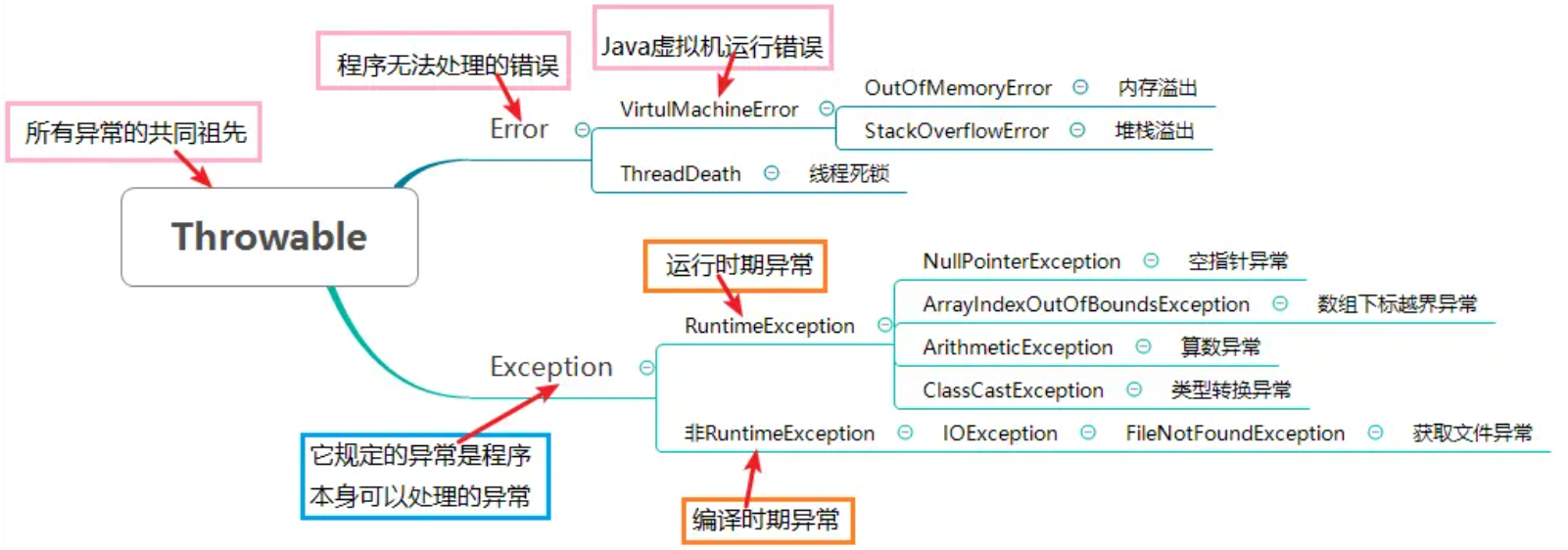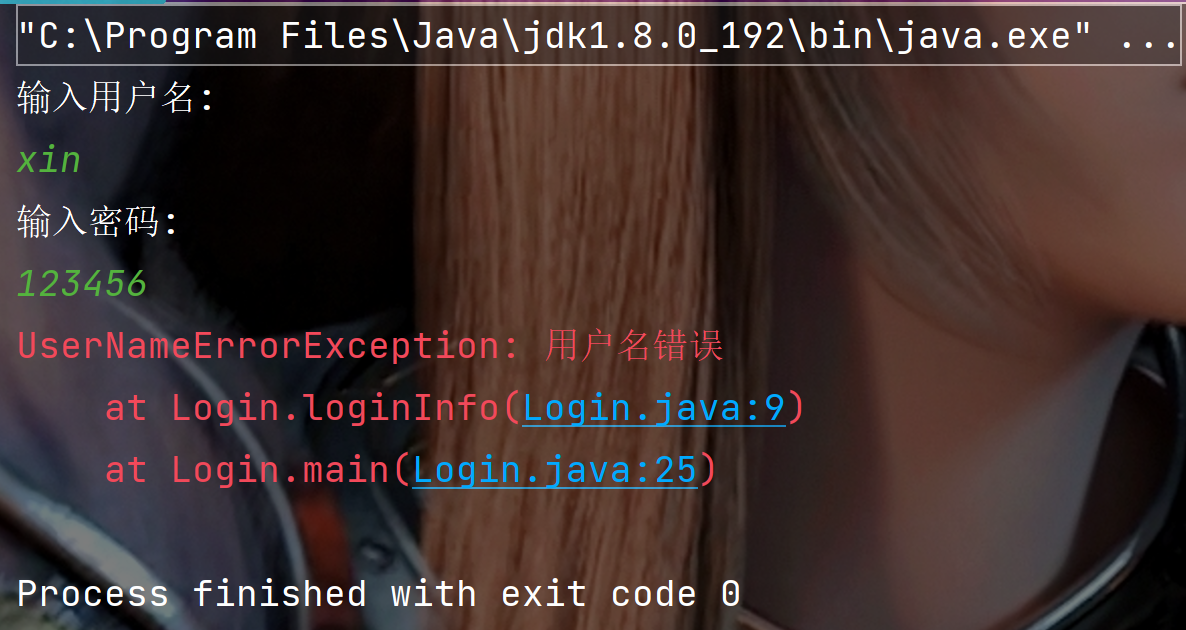一. 异常的概念和体系结构
1. 异常的概念
在Java中,将程序执行过程中发生的不正常行为称为异常;
java中不同类型的异常,都有与其对应的类来进行描述;程序发生异常实际上是new 了一个异常对象然后抛出去,再由程序或者JVM进行处理。
下面给出的是几个常见的异常:
- 算数异常
System.out.println(10 / 0);

- 数组越界异常
int[] arr = {1, 2, 3};
System.out.println(arr[66]);

- 空指针异常
int[] arr = null;
System.out.println(arr.length())

2. 异常的体系结构
异常种类繁多,为了对不同异常或者错误进行很好的分类管理,Java内部维护了一个异常的体系结构:

从上图中可以看到:
- Throwable :是异常体系的顶层类,其派生出两个重要的子类, Error 和 Exception
- Error :指的是Java虚拟机无法解决的严重问题,比如: JVM的内部错误 、 资源耗尽等 ,典型代表: StackOverflowError和OutOfMemoryError ,一旦发生回力乏术。
- Exception :异常产生后程序员可以通过代码进行处理,使程序继续执行。
3. 异常的分类
异常可能在编译时发生,也可能在程序运行时发生,根据发生的时机不同,可以将异常分为:
- 编译时异常
在程序编译期间发生的异常,称为编译时异常,也称为受检查异常(Checked Exception) ;比如: CloneNotSupportedException
- 运行时异常
在程序执行期间发生的异常,称为运行时异常,也称为非受检查异常(Unchecked Exception)
**RunTimeException以及其子类对应的异常,都称为运行时异常。**比如:NullPointerException、 ArrayIndexOutOfBoundsException、ArithmeticException。
注意:编译时出现的语法性错误,不能称之为异常。例如将 System.out.println 拼写错了, 写成了 system.out.println. 此时编译过程中就会出错, 这是 “编译期” 出错。而运行时指的是程序已经编译通过得到 class 文件了, 再由 JVM 执行过程中出现的错误.
二. 异常的处理
在Java中, 异常处理主要的5个关键字:throw、try、catch、final、throws。
1. 异常的抛出(throw)
在编写程序时,如果程序中出现错误,此时就需要将错误的信息告知给调用者,
在Java中,可以借助throw关键字,抛出一个指定的异常对象,将错误信息告知给调用者。具体语法如下:
throw new XXXException("异常产生的原因");
使用实例:
- 实现一个获取数组中任意位置元素的方法
public static int getElement(int[] array, int index){
if(null == array){
throw new NullPointerException("传递的数组为null");
}
if(index < 0 || index >= array.length){
throw new ArrayIndexOutOfBoundsException("传递的数组下标越界");
}
return array[index];
}
public static void main(String[] args) {
int[] array = {1,2,3};
getElement(array, 3);
}
- 执行结果

【注意事项】
- throw必须写在方法体内部
- 抛出的对象必须是Exception 或者 Exception 的子类对象
- 如果抛出的是 RunTimeException 或者 RunTimeException 的子类,则可以不用处理,直接交给JVM来处理(程序会直接终止)。
- 如果抛出的是编译时异常,用户必须处理,否则无法通过编译
- 异常一旦抛出,其后的代码就不会执行
2. 异常的捕获
异常的捕获,也就是异常的具体处理方式,主要有两种:异常声明throws 以及 try-catch捕获处理。
2.1 异常声明(throws)
处在方法声明时参数列表之后,当方法中抛出编译时异常,用户不想处理该异常,此时就可以借助throws将异常抛给方法的调用者来处理。即当前方法不处理异常,提醒方法的调用者处理异常。
语法格式:
修饰符 返回值类型 方法名(参数列表) throws 异常类型1,异常类型2...{
//...
}
比如Object类当中的clong方法就用throws来处理 CloneNotSupportedException 异常

而不管是在哪里要调用clone()方法,在重写clone方法之后都要继续声明throws CloneNotSupportedException以便将CloneNotSupportedException抛出。


【注意事项】
- throws必须跟在方法的参数列表之后
- 声明的异常必须是 Exception 或者 Exception 的子类
- 方法内部如果抛出了多个异常,throws之后必须跟多个异常类型,之间用逗号隔开,如果抛出多个异常类型具有父子关系,直接声明父类即可。
- 调用 声明抛出异常 的方法时,调用者必须对该异常进行处理,或者继续使用throws抛出; 如果是 受查异常 (如:CloneNotSupportedException) ,可以使用throws一直抛出,程序可以正常运行结束; 如果是 非受查异常,如果一直使用throws来处理,抛出到main方法后,最后是交给JVM处理的,程序会异常终止。
2.2 try-catch捕获并处理
throws对异常并没有真正处理,而是将异常报告给抛出异常方法的调用者,由调用者处理。如果真正要对异常进行 处理,就需要try-catch。
语法格式:
try{
// 将可能出现异常的代码放在这里
}catch(要捕获的异常类型 e){
// 如果try中的代码抛出异常了,此处catch捕获时异常类型与
try中抛出的异常类型一致时,或者是try中抛出异常的基类时就会被捕获到
// 对异常就可以正常处理,处理完成后,跳出try-catch结构,继续执行后序代码
}[catch(异常类型 e){
// 对异常进行处理
}finally{
// 此处代码一定会被执行到
}]
// 后序代码
// 当异常被捕获到时,异常就被处理了,这里的后序代码一定会执行
// 如果捕获了,由于捕获时类型不对,那就没有捕获到,这里的代码就不会被执行
注意:
1. []中表示可选项,可以添加,也可以不用添加
2. try中的代码可能会抛出异常,也可能不会
【注意事项】
- try块内抛出异常位置之后的代码将不会被执行
- 如果抛出异常类型与catch时异常类型不匹配,即异常不会被成功捕获,也就不会被处理,继续往外抛,直到JVM收到后中断程序----异常是按照类型来捕获的
- try中可能会抛出多个不同的异常对象,则必须用多个catch来捕获----即多种异常,多次捕获
public static void main(String[] args) {
int[] arr = {1, 2, 3};
try {
System.out.println("before");
// arr = null;
System.out.println(arr[100]);
System.out.println("after");
} catch (ArrayIndexOutOfBoundsException e) {
System.out.println("这是个数组下标越界异常");
e.printStackTrace();
} catch (NullPointerException e) {
System.out.println("这是个空指针异常");
e.printStackTrace();
}
System.out.println("after try catch");
}
- 如果多个异常的处理方式是完全相同, 也可以写成这样:
catch (ArrayIndexOutOfBoundsException | NullPointerException e) {
//...
}
- 如果异常之间具有父子关系,一定是子类异常在前catch,父类异常在后catch,否则语法错误(父类异常可以捕获到所有子类异常,子类异常再后永远都不会执行):
public static void main3(String[] args) {
try {
System.out.println(10/0);
int[] array = {1,2,3,4};
array = null;
System.out.println(array[10]);
}catch (ArithmeticException e) {
e.printStackTrace();//快速的定位异常出现的位置
System.out.println("你这里出现算术异常了!");
}catch (NullPointerException e) {
e.printStackTrace();
System.out.println("捕捉到了空指针异常!");
}catch (ArrayIndexOutOfBoundsException e) {
e.printStackTrace();
System.out.println("数组越界异常!");
}catch (Exception e) {
e.printStackTrace();
}
System.out.println("执行后续代码!");
}
- 可以通过一个catch捕获所有的异常,即多个异常,一次捕获(不推荐,影响代码的可读性)。
public static void main(String[] args) {
int[] arr = {1, 2, 3};
try {
System.out.println("before");
arr = null;
System.out.println(arr[100]);
System.out.println("after");
} catch (Exception e) {
e.printStackTrace();
}
System.out.println("after try catch");
}
由于 Exception 类是所有异常类的父类. 因此可以用这个类型表示捕捉所有异常.
备注: catch 进行类型匹配的时候, 不光会匹配相同类型的异常对象, 也会捕捉目标异常类型的子类对象.代码中的 NullPointerException 和 ArrayIndexOutOfBoundsException 都是 Exception 的子类, 因此都能被捕获到.
2.3 finally
在写程序时, 有些特定的代码,不论程序是否发生异常,都需要执行,比如程序中打开的资源 :网络连接、数据库 连接、IO流等, 在程序正常或者异常退出时,必须要对资源进进行回收 。另外,因为 异常会引发程序的跳转,可能导致有些语句执行不到 ,finally就是用来解决这个问题的。
finally中的代码一定会执行的,一般在finally中进行一些资源清理的扫尾工作。
语法格式 :
try{
// 可能会发生异常的代码
}catch(异常类型 e){
// 对捕获到的异常进行处理
}finally{
// 此处的语句无论是否发生异常,都会被执行到
}
// 如果没有抛出异常,或者异常被捕获处理了,这里的代码也会执行
代码示例:
public static void main(String[] args) {
try{
int[] arr = {1,2,3};
arr[100] = 10;
arr[0] = 10;
}catch (ArrayIndexOutOfBoundsException e){
e.printStackTrace();
}finally {
System.out.println("finally中的代码一定会执行");
}
System.out.println("如果没有抛出异常,或者异常被处理了,try-catch后的代码也会执行");
}
执行结果:

finally 和 try-catch-finally 后的代码都会执行,那为什么还要有finally呢,通过下面的代码进行理解;
下面的程序,如果正常输入,成功接收输入后程序就返回了,try-catch-finally之后的代码根本就没有执行,即输入流 就没有被释放,造成资源泄漏。
import java.util.InputMismatchException;
import java.util.Scanner;
public class TestFinally {
public static int getData(){
Scanner sc = null;
try{
sc = new Scanner(System.in);
int data = sc.nextInt();
return data;
}catch (InputMismatchException e){
e.printStackTrace();
}finally {
System.out.println("finally中代码");
}
System.out.println("try-catch-finally之后代码");
if(null != sc){
sc.close();
}
return 0;
}
public static void main(String[] args) {
int data = getData();
System.out.println(data);
}
}
// 正常输入时程序运行结果:
100
finally中代码
100
要解决上面的问题只需要对getData()方法中的代码稍作修改,将sc.close();放入finally中即可:
public static int getData(){
Scanner sc = null;
try{
sc = new Scanner(System.in);
int data = sc.nextInt();
return data;
}catch (InputMismatchException e){
e.printStackTrace();
}finally {
System.out.println("finally中代码");
//一定会被执行
sc.close();
}
System.out.println("try-catch-finally之后代码");
return 0;
}
也可以通过下面这种方式让程序自动关闭资源:
public static int getData(){
try(Scanner sc = new Scanner(System.in)){
int data = sc.nextInt();
return data;
}catch (InputMismatchException e){
e.printStackTrace();
}finally {
System.out.println("finally中代码");
}
System.out.println("try-catch-finally之后代码");
return 0;
}
finally 执行的时机是在方法返回之前(try 或者 catch 中如果有 return 会在这个 return 之前执行 finally). 但是如果 finally 中也存在 return 语句, 那么就会执行 finally 中的 return, 从而不会执行到 try 中原有的 return.
一般不建议在 finally 中写 return (被编译器当做一个警告).
public static void main(String[] args) {
System.out.println(func());
}
public static int func() {
try {
return 10;
} finally {
return 20;
}
}
执行结果:

3. throw和throws的区别
- 位置不同
- throw:方法内部
- throws:方法的声明处
- 内容不同
- throw + 具体的异常对象(只能抛出一个)
- throws + 异常的类型(可以是多个类型,用 ‘ , ’ 拼接)
- 作用不同
- throw:异常出现的源头,起制造异常的作用
- throws:在方法的声明处告诉方法的调用者,这个方法中可能会出现声明的这些异常,然后让调用者对这个异常进行处理(捕获或者继续向上抛出)
三. 异常的处理流程
- 程序先执行 try 中的代码
- 如果 try 中的代码出现异常, 就会结束 try 中的代码, 看和 catch 中的异常类型是否匹配.
- 如果找到匹配的异常类型, 就会执行 catch 中的代码
- 如果没有找到匹配的异常类型, 就会将异常向上传递到上层调用者.
- 无论是否找到匹配的异常类型, finally 中的代码都会被执行到(在该方法结束之前执行).
- 如果上层调用者也没有处理的了异常, 就继续向上传递.
- 一直到 main 方法也没有合适的代码处理异常, 就会交给 JVM 来进行处理, 此时程序就会异常终止.
四. 自定义异常类
Java 中虽然已经内置了丰富的异常类, 但是并不能完全表示实际开发中所遇到的一些异常,此时就需要维护符合我 们实际情况的异常结构.
自定义方式:
- 自定义异常类,然后继承自Exception 或者 RunTimeException
- 实现一个带有String类型参数的构造方法,参数含义:出现异常的原因
注意事项:
- 自定义异常通常会继承自 Exception 或者 RuntimeException
- 继承自 Exception 的异常默认是受查异常
- 继承自 RuntimeException 的异常默认是非受查异常
代码示例:
public class PassWorldException extends Exception{
public PassWorldException() {
super();
}
public PassWorldException(String message) {
super(message);
}
}
public class UserNameErrorException extends Exception{
public UserNameErrorException() {
super();
}
public UserNameErrorException(String message) {
super(message);
}
}
import java.util.Scanner;
public class Login {
private String userName = "rong";
private String passWoorld = "123456";
public void loginInfo(String userName,String passWoorld) throws UserNameErrorException,PassWorldException{
if(!this.userName.equals(userName)){
throw new UserNameErrorException("用户名错误");
}
if(!this.passWoorld.equals(passWoorld)){
throw new PassWorldException("密码错误");
}
System.out.println("登录成功!");
}
public static void main(String[] args) {
Scanner scanner = new Scanner(System.in);
System.out.println("输入用户名:");
String userName = scanner.nextLine();
System.out.println("输入密码:");
String passWorld = scanner.nextLine();
try{
Login login = new Login();
login.loginInfo(userName, passWorld);
}catch (UserNameErrorException | PassWorldException e){
e.printStackTrace();
}finally{
scanner.close();
}
}
}
执行结果:

